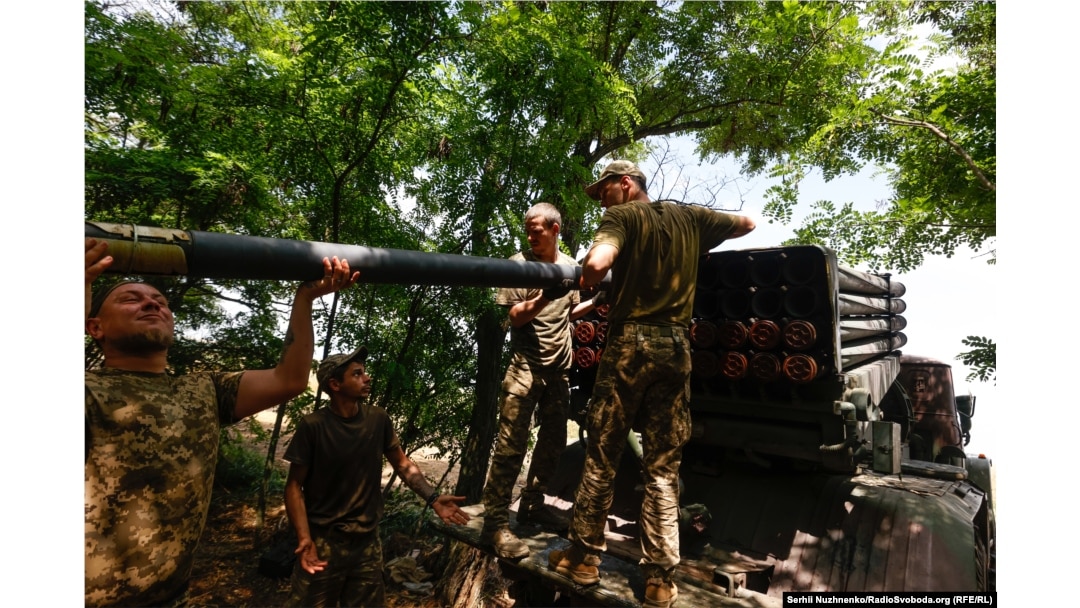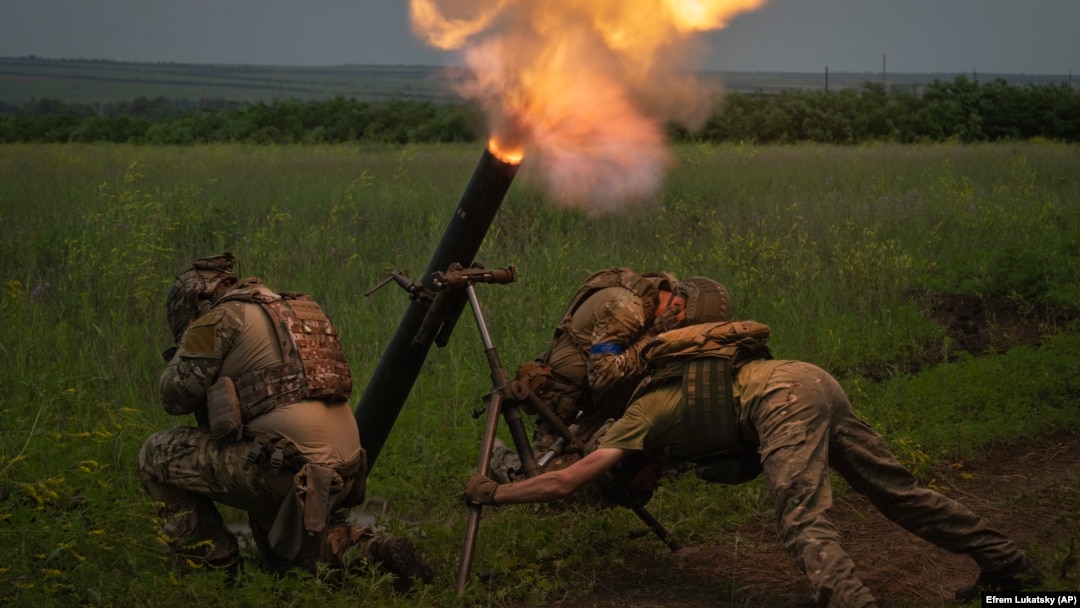Six weeks into a major counteroffensive that Ukrainian military commanders and political leaders hope will decisively change the course of the 17-month Russian invasion, this is where things stand:
About 1,500 meters of recaptured territory south of Orikhiv, in the Zaporizhzhya region; less than that south of Hulyaypole. South of the Donetsk region town of Velyka Novosilka, advances are greater: 8-9 kilometers from where the front line was prior to June 5. To the northeast, Ukrainian forces have clawed back a few hundred meters of high ground north and south of Bakhmut.
So, what does Ukraine have to show for its efforts?
In short, not much, and certainly no breakthrough of Russian lines. That's got some in the West concerned.

"It may not be at the speed that we would prefer," Lieutenant General Douglas Sims, director of operations for the U.S. Joint Chiefs of Staff, said last week.
"It's not as fast, but it's not catastrophically behind schedule," British Defense Secretary Ben Wallace said on the sidelines of a NATO summit in Vilnius on July 12.
After months of preparations and resupply -- with as many as nine newly constituted, NATO-trained armored brigades -- Ukraine's counteroffensive is going slowly. The amount of territory reclaimed so far is tangible but small. The amount of Western-supplied equipment, vehicles, and weaponry Ukraine has lost is substantial. The size and complexity of Russian defenses across southern and eastern Ukraine is formidable.

Ukrainian soldiers prepare to fire at Russian positions as part of the counteroffensive in the Zaporizhzhya region in early July.
"It was always going to be slow going, given all the defensive fortifications that the Russians have built," said Nick Reynolds, a land warfare research fellow at the Royal United Services Institute, a British think tank.
"It's not good or bad," he told RFE/RL. "It's just inherent to the situation that they're facing."
"It is slow," said Mark Cancian, a retired U.S. Marine colonel who is now a senior adviser at the Center for Strategic and International Studies in Washington, D.C.
"It's been going on for nearly a month, and the Ukrainians are not through the Russian defensive zone," he said in an e-mail. "They need to do that to employ all their new armored vehicles and reoccupy substantial territory. Fighting inside the defensive zone is an attritional battle like a World War I offensive. Russia is better situated for such a conflict because of its larger size."
"If you look at it from Ukraine's point of view, of course they would want the offensive to be over in a day," said Dick Berlijn, a retired Dutch Air Force general who served as the Netherlands' chief of defense from 2004-2008. "But that's not realistic."
"The Russians have had a long time to dig in, dig defensive structures," he told RFE/RL. "The battle right now is very different from the previous phase, when the Ukrainians drove the Russians east away from Kyiv."
'Very Difficult, Very Long, And Very, Very Bloody'
Ukraine first proved its mettle in the opening weeks after the February 24, 2022, invasion, when it thwarted an initial Russian attempt to seize the capital. Russia was forced to withdraw from the north and reposition its forces to the east.
The last time Ukraine recorded major battlefield victories and recaptured large pieces of territory was in the fall.
Ukrainian troops surprised the Russians, sweeping through much of the Kharkiv region in the northeast, moving as far east as the city of Lyman in the Donetsk region southeast of Kharkiv. To the south, Ukraine put thousands of Russian paratroopers at risk on the west bank of the Dnieper River in the Kherson region in November. Russian commanders ultimately ordered withdrawal to the opposite riverbank.
WATCH: Speaking to RFE/RL's Maryan Kushnir, Ukrainian soldiers fighting in the Zaporizhzhya region said their counteroffensive operations have been slowed by mines laid by Russian soldiers, enemy rocket attacks, and cluster munitions.
Your browser doesn’t support HTML5
'The Longer It Lasts, The Harder It Will Be': Ukrainian Forces Face 'Difficult' Advance In Zaporizhzhya Region
Over the winter, both sides dug in. Russia mounted what turned out to be half-hearted offensives in parts of the Donetsk and Luhansk regions. Russian marine infantry units incurred devastating losses near Vuhledar in February.
In May, regular Russian forces and mercenaries from the Wagner Group finally succeeded in capturing Bakhmut, after all but obliterating the city in seven months of urban warfare.
Ukraine used the time to try and ingest billions of dollars of Western-supplied tanks, armored vehicles, artillery, missiles, and ammunition into its forces. Alongside U.S.- and NATO-supplied trainers, Ukrainian forces sought to learn new battlefield tactics, shifting away from the Soviet doctrine that many of Ukraine's upper-rank officers were steeped in.
Sometime around June 5, after weeks of signaling and hinting, Ukrainian commanders launched the new offensive operations, focusing on three locations: near Orikhiv, near Velyka Novosilka, and around Bakhmut and Soledar.
Ukrainian troops took a series of villages south of Velyka Novosilka and seized high ground around Bakhmut -- north of the city and also to its south, near the village of Klishchiyivka. But in the Zaporizhzhya region, they also ran into what experts described as a meat-grinder of Russian fortifications -- layers of trenches, minefields, barbed wire, anti-tank defenses, pillboxes -- that forced Ukrainian units into narrow strips of land where they could be pummeled by Russian artillery.
The defenses have been dubbed "Surovikin Lines"-- named after General Sergei Surovikin, who briefly commanded the Russian forces invading Ukraine until he was demoted in January. An ally of mercenary chief Yevgeny Prigozhin, Surovikin has not been seen or heard from since Prigozhin's aborted mutiny last month.
At a speech in Washington on June 30, the chairman of the U.S. joint chiefs of staff defended Ukraine's progress.
"That it's going slower than people predicted doesn't surprise me at all," General Mark Milley said. "It's going to be very difficult, very long, and it's going to be very, very bloody, and no one should have any illusions about any of that."
"Ukrainian soldiers are assaulting through minefields and into trenches, and this is literally a fight for their life," Milley said. "So, yes, sure, it goes a little slow, but that is part of the nature of war."
Matter Of Timing?
Ukrainian President Volodymyr Zelenskiy pushed back earlier this month against criticism that Ukrainians weren't moving quickly enough. He also suggested that Ukraine's Western backers, who have worked closely with Ukrainian commanders, may have caused a delay in launching the offensive.
"I wanted our counteroffensive to happen much earlier, because everyone understood that if the counteroffensive unfolds later, then a bigger part of our territory will be mined," Zelenskiy said in an interview on CNN on July 5. "We give our enemy the time and possibility to place more mines and prepare their defensive lines."
Ukrainian soldiers take a rest near Bakhmut, Donetsk region, in May.
Western officials may have to recalibrate their expectations, Berlijn said.
"The Ukrainians have better weapons, now they're better trained, their stocks are better than they used to be, but again, we have to guard against unrealistic expectations," he said. "The Russians aren't stupid. Even if they lose a lot of personnel, they have strategic depth. And they're callous enough to throw lots of young Russians into battle."
"All of that means [Russia] is still a potent opponent, and we shouldn't be thinking this should be a walk in the park and they kick out the Russians in a day or two," he said.
Long-standing military doctrine holds that any defensive force has a far easier task when faced with any offensive force. And breaching well-constructed defensive lines is considered one of the most difficult tasks any army can take on: requiring specialized bridging equipment, mine-clearing vehicles, engineers, and sappers.
Ukraine doesn't have a lot of that, as the British defense secretary noted.
Ukraine "is doing what anyone else would do having to fight through minefields toward the Russian line," Wallace said, according to an official transcript. Ukrainians are having to "dismount and clear through those minefields on foot and then they have to clear the minefield literally by demining hand to hand."
Members of Ukraine's State of Emergency Service inspect an area for mines and unexploded shells near the village of Blahodatne, in the Mykolayiv region, on May 10.
"Russian combat engineers are very, very competent; their doctrine is nothing special, nothing new, to anyone who studied the Soviets in the 1970s and 1980," said Reynolds, who just returned from a research trip to Ukraine. "Russia is a big country, and they're just operating on a very, very big scale. They were given that opportunity to dig in, and they took advantage of it."
The Ukrainians "need more engineering equipment," he said. "They lack MCLICs"-- mine-clearing line charges used by military engineers to clear paths for infantry to move through mined terrain. "So they're resorting to hand defusing mines, which is incredibly dangerous."
Aside from the lack of breaching equipment and the strength of Russian defenses, some experts say there's another factor: The newly trained Ukrainian brigades received a crash course in NATO-style tactics and battlefield doctrine over a few months. By contrast, Western militaries train for years to master combined maneuvers and coordination across different units: infantry, armored, engineering, artillery, and signals, for example.
"Ukrainian forces have still not mastered combined arms operations at scale," Franz-Stefan Gady, a former senior fellow at the International Institute for Strategic Studies, wrote in a series of posts to Twitter.
Ukrainian soldiers hold a Ukrainian flag as they pose on top of a Challenger 2 tank during training at Bovington Camp, near Wool in southwestern England, on February 22.
"Much more impactful than the minefields per se on Ukraine's ability to break through Russian defenses is its inability to conduct complex combined arms operations at scale," Gady wrote.
While U.S-supplied Bradley armored vehicles and German-built Leopards have been spotted on the battlefield -- in at least one instance badly damaged -- it's also unclear whether Ukraine has in fact committed the NATO-trained brigades. In Western militaries, a brigade typically has between 3,500-4,000 troops, and in some places up to 5,000.
"Ukraine has not 'culminated,' to use a military term," said Cancian of CSIS. "It is still moving forward and has some uncommitted brigades."
The Prigozhin Factor
Some observers point to another wild card that may affect the counteroffensive: Prigozhin's mutiny and the continuing fallout, which has included several top Russian commanders going missing -- reportedly demoted, dismissed, or detained -- or being publicly insubordinate.
"There's always the possibility that the Russians might weaken, perhaps because of losses and perhaps because of the unstable politics behind the front," Cancian said in his e-mail.
"We would hope you would see a bigger breach, a real breach of the Russian lines, that would develop further and degradation of the Russian forces," Berlijn said. "Whether that is realistic? We shouldn't underestimate the conditions that the Ukrainians are facing right now."


